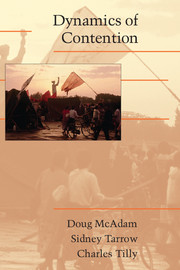Book contents
6 - TRANSFORMATIONS OF CONTENTION
Published online by Cambridge University Press: 05 June 2012
Summary
In May 1856, Charles Sumner, a well-known Massachusetts abolitionist, was bludgeoned almost to death after delivering a speech in the United States Senate on “The Crime Against Kansas” (Sewell 1976: 279–280). Vituperative even for its day, Sumner's speech attacked a South Carolina Senator, Andrew Butler, for supporting the violent proslavery forces in Kansas. This so infuriated Butler's cousin, Representative Preston Brooks, that he came up to Sumner on the Senate floor, accused him of slandering both his relative and his state, and beat him senseless (Ransom 1989: 153). Sumner survived Brooks' assault. But coming as it did in the midst of attacks by pro-slavery forces on antislavery settlers in Kansas, “Bloody Sumner” joined “Bloody Kansas” as a symbol around which the coalition joining the issues of free soil, free land, and free people in the new Republican Party rallied. “Now is the beginning of the Second ‘American Revolution,’” warned a correspondent of abolitionist Ben Wade (quoted in Sewell 1976: 280). He was right – but no one guessed the enormity of the bloody civil war that would follow.
On December 20, 1973, a greater act of violence exploded in Franco's Spain, where another civil war had ushered in a dictatorship three decades earlier. In a narrow street in Madrid, a bomb planted by the Basque terrorist group, ETA, killed the President of Franco's government, Luis Carrero Blanco (Payne 1987: 588–90; Reinares 1987: 123).
- Type
- Chapter
- Information
- Dynamics of Contention , pp. 160 - 190Publisher: Cambridge University PressPrint publication year: 2001

